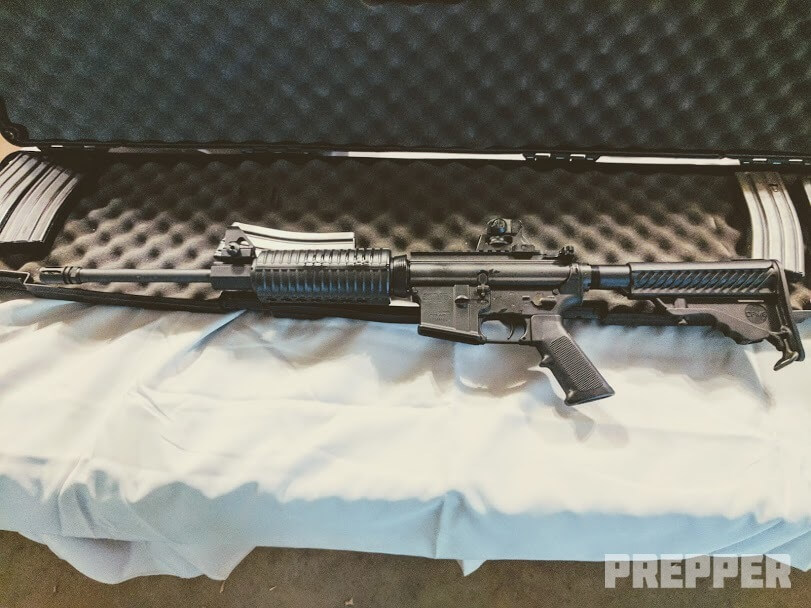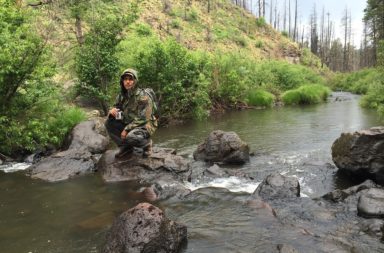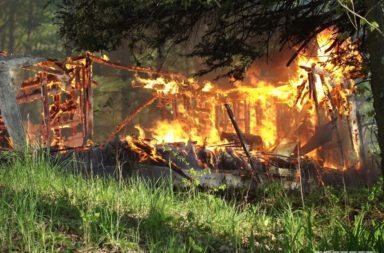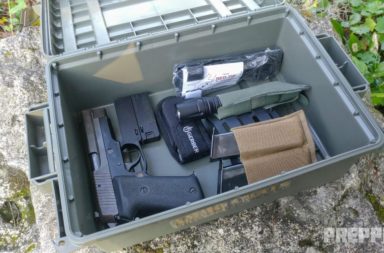Creating a place where you can practice shooting all of your weapons as often as possible will vastly increase your aim and tactical readiness. It also gives you the opportunity to learn more about how the weapons function, how to sight them, repair them, and hopefully how to reload the ammo you collect off the ground.
Building your own gun range sounds like an exciting proposition, doesn’t it? It was near the top of our “to do” list once we finally found our dream survival homesteading retreat land. There was one gun range in our rural county at the time, and shooting semi-automatic rifles was strictly prohibited.
Once we moved, we could finally hone our marksmanship skills and teach other members of our tribe how to improve their own, or show younger members of our prepper group how to safely handle a gun for the very first time.
We turned a weekend spent building the gun range–with nearly 100 percent scrap materials–into a fun survival work detail that concluded with a meal cooked in the smoker and sipping on some cold drinks. Prepping sure can be fun!
 Legalities
Legalities
I live in a rural county that has only one stoplight, no building permit office, or zoning office of any type. Basically, I can walk outside and build whatever my prepper heart desires (aside from a septic system), but not everyone is so lucky. Not hearing guns fire around here on a daily basis would be rather disconcerting.
Before investing a single dime in backyard gun range supplies, thoroughly review all local laws to determine if a building a gun range is permissible and what type of restrictions apply. In some areas, a person must own a minimum of 10 acres of land before a gun range can be created, and then inspections of the range might be required before it can be put into use.
A land requirement of at least two and a half acres might exist if you want to shoot rimfire rifles on the DIY gun range, in some localities.
How To Build A Gun Range
Location Selection
Choosing the location for the home gun range is the most important aspect of the entire project. The target area must have either a safe natural or man-made backstop that can stop any round which will be fired into a target.
We are blessed to live in the hills of Appalachia, so building a backstop was not necessary. We made use of an otherwise useless spot of land to build the gun range – with a pond in front of it. The area was dug out with a backhoe by the previous land owners who wanted to build a house on that particular spot.
You hit hard rock about three feet down and when it rains, the area in front of the hillside turns into a marsh. To create a visually pleasing spot that can also double as a close shooting area for handguns and novice shooters, we created an “island” in the middle of the pond shooting range (my beloved husband Bobby always said he wanted to own an island). It is a small space complete with just a picnic table that doubles as a shooting bench, and a fire ring.
If you need to build a backstop because the natural attributes of the land are not useful for this purpose, heavy equipment will almost assuredly be required. It takes a whole lot of dirt to build a backstop tall enough and deep enough to safely serve as a backstop for ammo rounds to be fired into it.
Some folks opt to build a dirt backstop that is not quite as thick as is necessary and then build a wall in front of it using railroad ties to ensure any round fired at the gun range will definitely be stopped before it can go past the backstop.
Installing Posts
As in all things in life, a gun range must have a solid foundation. The holes for the target support should be dug at least three feet deep.
The type of posts you will need will depend on both target dimension and weight. It is likely you will need different size posts for the various targets, unless you want to go with a uniform look and use sturdy wood posts for all targets for aesthetic reasons.
The post holes should be filled with mixed concrete and allowed to cure completely before attaching targets to the posts. While the concrete cures, you can focus on building the targets out of found or scrap materials.
Target Support Boards
You can build each target as a single component to your homemade gun range, or connect a series of target holders together (fence style) for added stability and uniformity.
Support boards connected securely to the posts are most commonly made out of either plywood or sheet metal. If using plywood, it is highly recommended to use pressure treated boards that are at least a half an inch thick for increased longevity.
Mobile PVC Target Stands
Mobile target stands for use with lightweight targets can be constructed out of PVC pipe. While must folks prefer to spend their time making permanent target posts and holders, there can be some value to creating a more portable option to use for low caliber rounds and bow practice.
- A mobile PVC target can be placed in varying spots around the gun range to allow for short distance practice – if you don’t build a pond with an island like we did.
- To set up a young shooter training area when needed.
- To practice shooting in different types of sunlight and shadow throughout the day on the homemade gun range.
- Frugality – these targets will not last forever, but they are cheap and easy to make and will get you out onto the new range quickly.
The Home Defense Gun website offers a great step-by- step article for building inexpensive PVC targets for home gun ranges.
Targets
Now for the most exciting part of building a backyard gun range…making targets! You can go the easy route and simply staple some store bought paper targets to your plywood supports and start shooting. There is nothing wrong with that, but since the gun range is on your own property, you can create DIY targets that area lot more interesting, difficult, that move, and even explode, when hit.
Top 6 Homemade Target Options
1. Plastic Jugs or Bottles
Plastic jugs or bottles filled with colored water that are either attached to the target supports or allowed to dangle free to simulate a moving target. Use glow in the dark paint or cheap glow sticks from the Dollar Tree to adorn plastic bottles so you can practice shooting in low-light and dark conditions.
2. Tannerite
Tannerite is favorite type of target. If it is legal to use in your area, learn how to safely mix the low-level explosive and pour it into a jug, aluminum can, animal decoy, or just about anything else you could fire a round into. We once hosted a gender reveal party on our gun range and mixed colored chalk (blue or pink) into the tannerite so when the expecting couple fired into the target simultaneously, they discovered the sex of their next bundle of joy.
3. Balloons
Balloons filled with sand, water, or colored water can also be used as either stationary or moving targets.
4. Tree Branches
A tree branch tied to a rope from to sturdy posts connected by a support board across the top also makes a superb moving target on a DIY gun range.
5. Pumpkins
Place pumpkins (or smaller produce if you are skilled enough) on top of the target posts. Shooting at a pumpkin in a great way to teach gun safety to children. When I took my CCW test, the instructor said he had his young daughters watch him shoot a pumpkin he had placed on a stump. They cheered and thought it was great fun when their daddy hit the pumpkin dead center on the first try.
After he lowered his weapon, my instructor asked his daughters to go try and put the pumpkin back together. An important chat about the permanent effect of firing a weapon at anything on anyone then took place.
6. Scrap Metal
Metal scrap can also be turned into extremely durable targets. When using metal, you must make sure the depth of the material is not so thin that it is destroyed quickly, and most importantly that the chance of a round ricochet does not exist.
Range Bench
You can invest a few hundred dollars into a gun range bench, or make one yourself for a fraction of the price. As noted above, a picnic table makes a decent starter multi-purpose range bench.
You can also use cinder blocks as supports for a piece of plywood cut to fit as a tabletop to create a gun range stand, and simply pull up an outdoor chair to sit upon.
For added safety, use markings of some type to outline the range area and any accessible area behind the backstop. Spray paint works fine for a while, but will need placed around the perimeter again once the grass is cut–or in our case, eaten by the horses.
A colorful yet thin piece of rope line can be staked around the range to better protect any visitors, workers, or children from wandering close to a live fire area, even when it does not appear to be in use.
Conclusion
Building your own gun range requires some upfront research into your local laws and regulations, having the right land with a natural or man-made backstop available, and some basic carpentry skills. But with a little elbow grease and a modest budget, you’ll never have to pay another range fee again!


